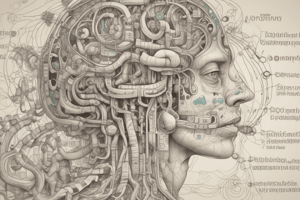Podcast
Questions and Answers
What is the role of the orbitofrontal area in the olfactory system?
What is the role of the orbitofrontal area in the olfactory system?
The orbitofrontal area is important for odor identification and discrimination. People with damage to this area have difficulty identifying different odors.
What is the direct connection of the olfactory nerve (CN I) to the brain?
What is the direct connection of the olfactory nerve (CN I) to the brain?
The olfactory nerve (CN I) transmits sensory information directly to the olfactory bulb and various regions of the brain responsible for processing and interpreting olfactory stimuli.
What is the phenomenon of olfactory adaptation, and what is its significance?
What is the phenomenon of olfactory adaptation, and what is its significance?
Olfactory adaptation is the ability of the olfactory system to adjust sensitivity to odors over time, optimizing the detection of changes in the surroundings.
How do axons from the olfactory tract project to other brain regions, and what is the significance of these connections?
How do axons from the olfactory tract project to other brain regions, and what is the significance of these connections?
What is the significance of the nasal cavity structure in the olfactory system?
What is the significance of the nasal cavity structure in the olfactory system?
What is the role of the cranial nerve I (olfactory nerve) in the olfactory system?
What is the role of the cranial nerve I (olfactory nerve) in the olfactory system?
What is the purpose of the olfactory receptor cells in the olfactory epithelium?
What is the purpose of the olfactory receptor cells in the olfactory epithelium?
What is the result of the axons from olfactory receptor cells combining with axons from other receptor cells?
What is the result of the axons from olfactory receptor cells combining with axons from other receptor cells?
What is the olfactory pathway responsible for?
What is the olfactory pathway responsible for?
What is adaptation in the context of smell?
What is adaptation in the context of smell?
What is the location of the olfactory receptor cells?
What is the location of the olfactory receptor cells?
What is the function of Cranial Nerve I (CNI)?
What is the function of Cranial Nerve I (CNI)?
What is the structure that odor molecules interact with in the olfactory epithelium?
What is the structure that odor molecules interact with in the olfactory epithelium?
What is the role of the nasal cavity in the sense of smell?
What is the role of the nasal cavity in the sense of smell?
What is unique about the olfactory nerve among cranial nerves?
What is unique about the olfactory nerve among cranial nerves?
What is the primary function of the olfactory nerve?
What is the primary function of the olfactory nerve?
What is the definition of odor threshold?
What is the definition of odor threshold?
What is the process by which our sense of smell becomes less sensitive to a particular odor over time?
What is the process by which our sense of smell becomes less sensitive to a particular odor over time?
What is the location of the olfactory bulb in the brain?
What is the location of the olfactory bulb in the brain?
Why do we initially notice strong smells more strongly when we enter a room?
Why do we initially notice strong smells more strongly when we enter a room?
What is the significance of the nasal cavity in olfaction?
What is the significance of the nasal cavity in olfaction?
What is the characteristic of olfactory receptors that allows us to detect odors at very low concentrations?
What is the characteristic of olfactory receptors that allows us to detect odors at very low concentrations?
Flashcards are hidden until you start studying
Study Notes
The Olfactory Pathway
- The olfactory pathway refers to the series of structures and connections involved in the sense of smell, from the detection of odorants in the environment to the perception of smell in the brain.
Olfactory Receptor Cells
- Located in the olfactory epithelium
- Each olfactory receptor cell has an axon extending from its basal surface
- The olfactory receptor cells have two main projections: one projection is a dendrite that extends to the surface of the olfactory epithelium, and the other is an axon that projects to the brain
- Dendrites have 10-20 non-motile cilia containing receptors for odor molecules
The Olfactory Nerve
- Also known as Cranial Nerve I (CN I)
- Composed of unmyelinated axons and lacks a protective covering called the myelin sheath
- Carries sensory information related to smell from the nasal cavity to the brain
- Projects directly to the olfactory bulb located at the base of the brain
Odor Thresholds
- The lowest concentration of a particular odorant in air that can be perceived by the human sense of smell
- Varies depending on the specific odorant and the individual's sensitivity to that odorant
- Only a few molecules of certain substances need to be present in air to be perceived as an odor
Adaptation
- The process by which our sense of smell becomes less sensitive to a particular odor over time, even if the concentration of the odor remains constant
- Occurs because our sensory receptors become less responsive to the constant stimulus
- Example: entering a room with a strong smell, you might initially notice it strongly, but become less aware of it over time
Olfactory Processing in the Brain
- Axons from the olfactory tract project to the limbic system and hypothalamus, playing a crucial role in emotional and memory-evoked responses to odors
- Pathways also extend to the frontal lobe, with the orbitofrontal area being an important region for odor identification and discrimination
Studying That Suits You
Use AI to generate personalized quizzes and flashcards to suit your learning preferences.




